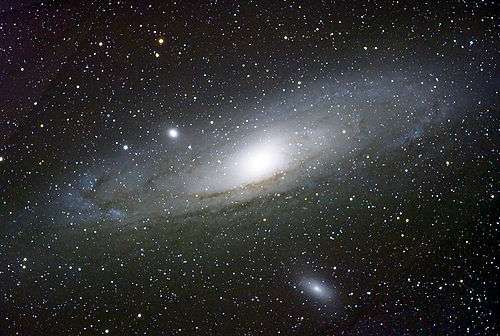Estimates of the number of galaxies in the universe range from 10 billion to over 100 billion.
According to Hubble's Law, galaxies are red-shifted. This means that they're moving away from us.
The most common form of classification for galaxies is based on the visible structure of the galaxy, organized in a form called the Hubble Diagram. The Hubble diagram is a pictoral representation of galaxy types developed by Edwin Hubble. It is also called the tuning-fork diagram as a result of its shape. Galaxy types are divided as follows:
| / | Sa | Sb | Sc | ||||||||
| E0 | ... | E7 | S0 | Ir | |||||||
| \ | SBa | SBb | SBc |
where E0 to E7 are elliptical galaxies, S0 is a transitional type, Sa to Sc are spiral galaxies, SBa to SBc are barred spiral galaxies, and Ir are irregular galaxies.
- Elliptical galaxies have an ellipsoidal form, with a fairly even distribution of stars throughout. The number gives the degree of eccentricity: E0 galaxies are nearly spherical, while E7 are greatly elongated.
- S0 galaxies appear to have a disk-like structure with a central spherical "bulge" projecting from it. They do not show any spiral structure.
- Spiral galaxies have a central "bulge" and an outlying "disk"; the disk is notable for having spiral "arms" within it, centered on the bulge. Sa galaxies have very "tightly wound" arms, while Sc galaxies are very loose spirals.

- As spiral galaxies mature, the center becomes red. The arms are bluish.
- Barred spiral galaxies have a similar sort of spiral structure to spiral galaxies, but instead of emanating from the bulge, the arms project out from the ends of a "bar" running through the bulge, like ribbons on either end of a baton. Again, SBa to SBc refer to how "tightly wound" these arms are.
- Irregular galaxies show no clearly discernable or regular shape. (E.g. the large and small Magellanic Clouds, which can be seen from Earth's southern hemisphere.)
Hubble based his classification on photographs of the galaxies through the telescopes of the time. He originally believed that elliptical galaxies were an early form, which might later evolved into spirals; our current understanding suggests that the situation is roughly opposite.
More modern observations of galaxies have given us the following information about these types:
- Elliptical galaxies are generally fairly low in gas and dust, and are composed mostly of older stars.
- Spiral galaxies generally have plentiful supplies of gas and dust, and have a broad mix of older and younger stars.
- Irregular galaxies are fairly rich in gas, dust, and young stars.
From this, astronomers have constructed a theory of galaxy evolution which suggests that ellipticals are, in fact, the result of collisions between spiral and/or irregular galaxies, which strip out much of the gas and dust and randomize the orbits of the stars.
Young galaxies are more blue, while old galaxies are more red.